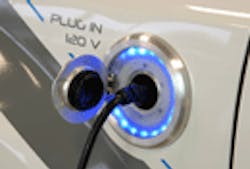Key to green trucks will be operational savings over time
Two new studies conclude that adoption rates for alternative-fueled vehicles (AFVs) will significantly climb among consumers and commercial users alike if specific “compensation” targets are achieved. In other words, the higher purchase price for AFVs – regardless of all-electric, hybrid, hydrogen fuel cell, or natural gas power – must be balanced by operational savings over time.
The first study, from the Mineta Transportation Institute (MTI), examined consumer preferences for four different AFVs: hybrid electric vehicles (HEVs), compressed natural gas (CNG) vehicles, hydrogen fuel cell (HFC) vehicles, and electric vehicles (EVs).
In the Mineta report, Understanding Household Preferences for Alternative-Fuel Vehicle Technologies, authors Hilary Nixon and Jean-Daniel Saphores found a $1,000 increase in AFV cost must be compensated by a $300 savings in driving cost over 12,000 miles or by a 17.5-mile increase in vehicle range or by a 7.8-minute decrease in total refueling time (e.g., finding a service station and refueling).
"Although one-third of respondents ranked gasoline-fueled vehicles as their first choice, 20% of respondents ranked gasoline vehicles last, and there is a strong interest in AFVs,” said Nixon. “Although no AFV type is overwhelmingly preferred, HEVs seem to have an edge, which probably reflects the fact that a number of popular HEVs have been available for several years.”
Full EVs are the least popular of the AFVs the respondents were asked to consider. In fact, they were ranked last by 40% of the respondents, Saphores noted. He also pointed out that the current limitations of EVs in range and recharging time are still a deterrent to their widespread household adoption.
Those findings dovetail to a degree with a study conducted by the Boston Consulting Group (BCG) entitled Powering Autos to 2020: The Era of the Electric Car?
“Electric vehicles will undoubtedly play an increasingly large role in many countries' plans in the decades ahead as energy independence and environmental concerns intensify, but they will gain only modest ground to 2020,” said lead author Xavier Mosquet, a senior partner in BCG’s Detroit office and global co-leader of its automotive practice.
“Gasoline- and diesel-powered vehicles are improving faster than expected and will continue to dominate the global landscape,” he pointed out.
Based solely on total-cost-of-ownership (TCO) economics, Mosquet said EVs will not be the preferred option for most consumers. Battery-pack costs are forecast to fall sharply (approximately 64% from 2009 levels) to $360 to $400 per usable kilowatt-hour (kWh) by 2020.
However, he stated, to the consumer, this still represents a cost of $9,600 per vehicle for the typical 20-kWh battery necessary for a “pure” battery EV.
But high costs notwithstanding, Mosquet noted that EVs will see relatively strong uptake from a distinct segment of environmentally conscious consumers around the world who are willing to pay an average up-front premium of $4,500 to $6,000 to purchase a green vehicle; do not expect their up-front investment to be recouped over time through lower operating costs; and are willing to pay about 10% to 20% more in terms of the TCO over the vehicle's life.
These very green buyers represent 13% of consumers in China, 9% of those in Europe, and 6%tof those in the U.S., according to BCG’s research. That means that China and Europe and not the U.S., as many believe, will be the largest markets for EVs in 2020.
“China is a major wildcard,” observed Mosquet. “ Assuming that the government remains committed to EVs, BCG projects that these vehicles will represent 7% of the country's new-car sales in 2020. Despite this moderate penetration, China will become the world's largest market for EVs due to its overall market size.”
Marco Gerrits, a partner in BCG's Beijing office, noted that the Chinese government has ambitious plans to drive adoption of EVs. The latest draft plan calls for 500,000 EVs – passenger cars, trucks, and buses – to be operating on its roads by 2015-- and 5 million by 2020. In 2010, however, only around 2,000 electric cars were sold there despite central-government incentives worth up to $9,000.
Taken together, BCG estimates that EVs and HEVs could claim 15% of aggregate new-car sales in the four major markets (North America, Europe, China, and Japan) in 2020.
"There is little doubt that regulations and oil prices, as well as technology and consumer preferences, create a high degree of uncertainty," noted Mosquet.
"All market participants have to prepare for and retain the flexibility to switch among at least three different paths the industry could take,” he advised.
“There’s the ‘pragmatist’ path, with a focus on internal combustion engine (ICE) improvements, HEVs, and a limited share of EVs.
“There’s also the ‘breakthrough’ path, marked by a game-changing improvement in battery technology.
Finally, there is the ‘green’ path, where oil prices greater than $250 per barrel drive strong government support for EVs and HEVs and, potentially, CNG.”
About the Author
Sean Kilcarr
Editor in Chief
Sean Kilcarr is a former longtime FleetOwner senior editor who wrote for the publication from 2000 to 2018. He served as editor-in-chief from 2017 to 2018.
